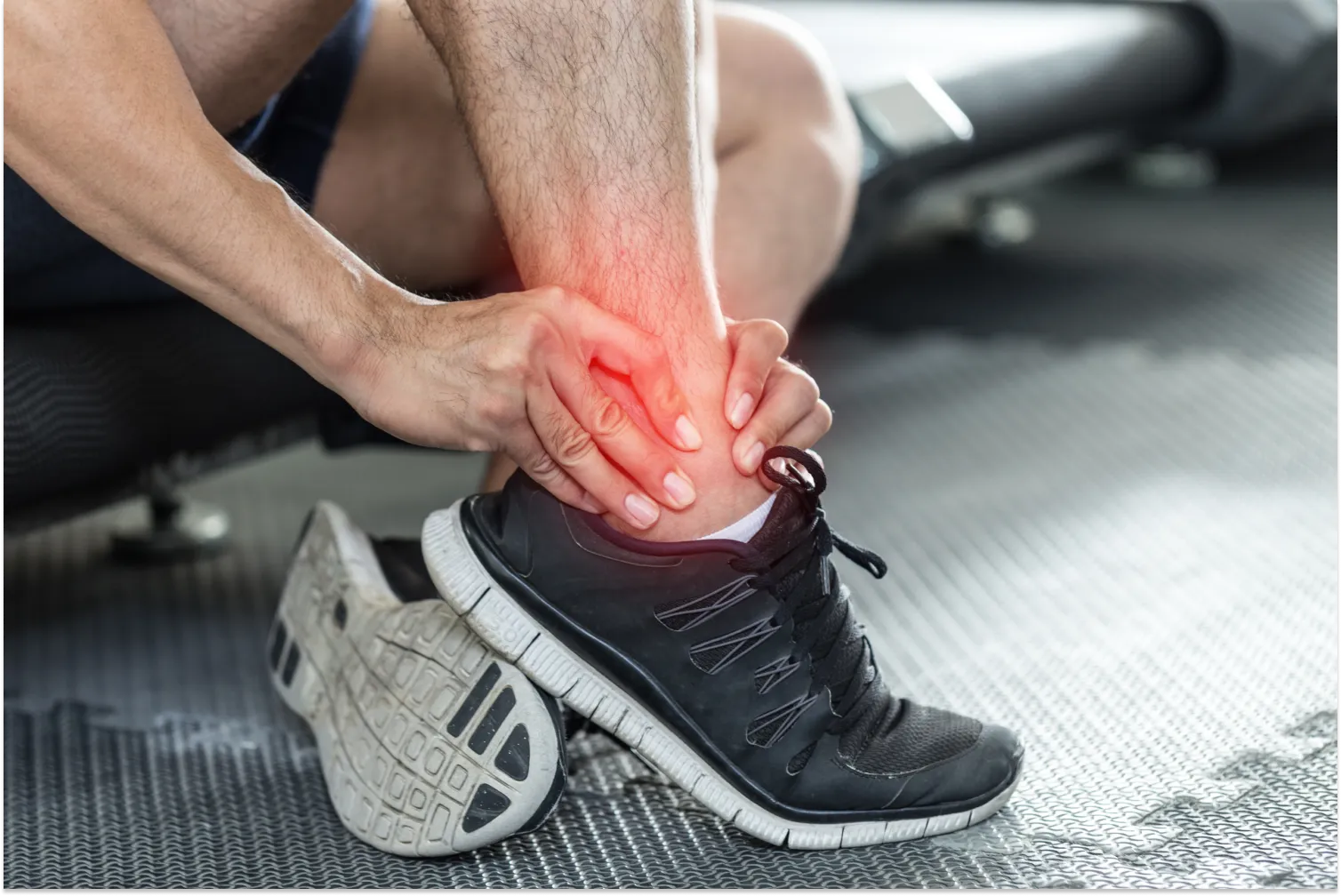Medically Reviewed By | Johannah Gregg, DNP FNP-C
While perhaps not the most glamorous part of the body, our ankles play an essential role in movement and day-to-day activities. These sturdy joints where the leg bones meet the feet are tasked with bearing the brunt of your body weight, enabling mobility and balancing the body.
As are remarkable feats of natural engineering, ankle injuries and discomfort can have far-reaching impacts on our overall well-being. Understanding your ankles, from ligaments to joint structures, is your first step towards maintaining their health and your overall well-being.
How Does Our Ankle Autonomy Work?
Your ankle, seemingly simple, is a complex joint composed of multiple parts, each serving a crucial function. At its core, the ankle joint connects three bones: the tibia and fibula — two bones in your lower leg — and the talus, a foot bone.
The ligaments, tough bands of tissue, bind these bones together and provide stability. Then, the Achilles tendon, the body's thickest and strongest tendon, connects your calf muscles to your heel bone, aka calcaneus.
These elements, working together, support your body weight, enable movement, and absorb stress as you walk, run, or jump. Understanding this anatomy sets the foundation for recognizing potential issues and taking proactive steps to prevent or manage ankle pain.
What Are Common Causes of Ankle Pain?
Ankle pain is often the result of an injury or a chronic condition. Let's take a closer look at some common causes.
1. Ankle Sprains
Sprained ankles are one of the most common injuries, particularly among athletes and individuals who lead active lifestyles. They typically occur when the ligaments — the soft tissues that hold the ankle bones in place — stretch beyond their normal range or tear. This often happens due to a foot twist, turn, or roll that forces the ankle out of its normal position.
Kate Panawash, Doctor of Physical Therapy, notes, “There are a few types of ankle sprains, the lateral ankle sprain seems to be the most common and also has a high recurrence rate.”
2. Overuse
Overuse of the ankle can lead to a variety of issues, ranging from swelling to more severe conditions like tendinopathy. Repetitive movements or extended strain can cause tissues to wear down over time, leading to pain and discomfort. Overuse can also lead to a build-up of uric acid, especially when paired with other risk factors.
3. Achilles Tendinitis
This common condition affects the Achilles tendon, which connects your calf muscles to your heel bone. It's often swelling in the tissues caused by overuse, particularly in sports that involve running and jumping. Individuals with flat feet may be more susceptible to Achilles Tendinitis due to the additional strain placed on the tendon by the kinematics of their foot structure. Dr. Panawash notes that this is more common in men versus women, and the highest incidence is around the 30-50 age range.
4. Stress Fractures
Stress fractures are small cracks in the bone often found in athletes who've recently increased their activity level. They can occur in various bones of the foot & ankle, including the tibia, fibula, and talus. Stress fractures often result from overuse and failure to allow the body adequate rest between intense workouts.
5. Ankle Fracture
An ankle fracture refers to any break in the tibia, fibula, or talus — the three main bones that make up the ankle joint. These fractures are typically the result of a direct impact or trauma, such as a fall or accident. Depending on the severity, treatment can range from splints and casts to surgical intervention.
6. Plantar Fasciitis
Plantar Fasciitis is an uncomfortable condition that occurs at the plantar fascia — a thick band of tissue that runs across the bottom of your foot and connects your heel bone to your toes. It's commonly seen in runners and individuals with flat feet, high arches, or extra body weight, placing extra pressure on the foot.
Dr. Panawash says, “The pain is usually located on the heel. Hallmark signs are that it is difficult to walk first thing in the morning or after periods of prolonged sitting.”
7. Ankle Arthritis
Arthritis of the ankle affects the joint where the tibia, fibula, and talus meet. The two primary types of arthritis that can affect the ankle include Osteoarthritis, a degenerative condition typically resulting from wear and tear over time, and Rheumatoid Arthritis, an autoimmune condition where the immune system mistakenly attacks the body's joints, causing discomfort.
Each cause can manifest differently in terms of pain, discomfort, and mobility limitations. Recognizing these symptoms is the first step toward seeking appropriate care. Getting an evaluation by a Physical Therapist or speaking to your physician can help you determine which type of arthritis you may have.
How To Recognize Different Types of Ankle Pain
Recognizing and understanding your ankle pain is crucial. Symptoms can vary based on the cause of your discomfort.
For instance, an ankle sprain may cause tenderness, swelling, and bruising. At the same time, Achilles tendinitis might present as a mild ache behind your ankle or above your heel after running or other sports.
Plantar fasciitis often causes sharp pain in the heel or the bottom of the foot. Ankle arthritis, including osteoarthritis and rheumatoid arthritis, usually results in joint stiffness, swelling, and chronic pain.
Each type of pain is your body's way of signaling a problem. Don't ignore persistent discomfort or severe pain. It's important to consult a healthcare provider, like a Physical Therapist or an orthopedic specialist to accurately identify and address your issue.
How Is Ankle Pain Diagnosed?
Diagnosing ankle pain often involves an X-ray or physical examination. Your healthcare professional may assess your range of motion, the degree of swelling, and your ability to bear weight. Sometimes, an orthopedic specialist or podiatrist might recommend an MRI or CT scan for a more detailed view of your ankle.
Remember, self-diagnosis can be risky. Always seek professional help to ensure a correct diagnosis and appropriate treatment plan.
Promoting Relief for Ankle Pain: Exploring Your Options
Experiencing ankle pain is more than a simple inconvenience; it can significantly impact your daily life. Although over-the-counter meds such as NSAIDs, like Ibuprofen, are often the first line of defense, their potential side effects may lead you to explore alternative solutions.
Depending on the cause of your ankle pain, a medical professional may suggest physical therapy. By working with a qualified Physical Therapist, you can engage in targeted exercises designed to restore your range of motion, strengthen your ankle and lower leg, and, ultimately, alleviate pain. Physical therapy is especially beneficial for those recovering from ankle injuries, aiding in the body's natural healing process.
Incorporating lifestyle changes can also play a significant role in promoting ankle health. Integrating warm-up routines and specific exercises into your daily regimen helps to strengthen your ankles and lower leg muscles, helping to prevent further pain or injury.
Another unique approach to easing ankle discomfort is the Incrediwear Ankle Sleeve. Merging science and comfort with its innovative semiconductor technology, our Ankle Sleeve provides targeted support as it releases negative ions upon skin contact.
This method can help support blood flow, delivering essential oxygen and nutrients to your affected area to provide relief and support your body's inherent healing abilities.
The Bottom Line
Understanding and caring for your ankles is paramount to overall well-being. Don't ignore persistent ankle pain. Seek professional help, and remember tools like the Incrediwear garments can support your recovery journey.
Trust in your ability to heal and continue to move towards a healthier, active lifestyle. You've got this!
Sources:
Ankle Ligaments: What Are They, Functions & Injury | Cleveland Clinic
High plasma uric acid concentration: causes and consequences | PMC
Stress fractures - Symptoms & causes | Mayo Clinic
Autoimmune Disease: Why Is My Immune System Attacking Itself? | Johns Hopkins Medicine
Read more

Medically Reviewed By | Johannah Gregg, DNP FNP-C If you want to reduce body fat, increase muscle mass, or just stay on top of your health, lifting weights is one of the most effective ways to exer...

Medically Reviewed By | Johannah Gregg, DNP FNP-C If you want to reduce body fat, increase muscle mass, or just stay on top of your health, lifting weights is one of the most effective ways to exer...






Leave a comment
All comments are moderated before being published.
This site is protected by hCaptcha and the hCaptcha Privacy Policy and Terms of Service apply.